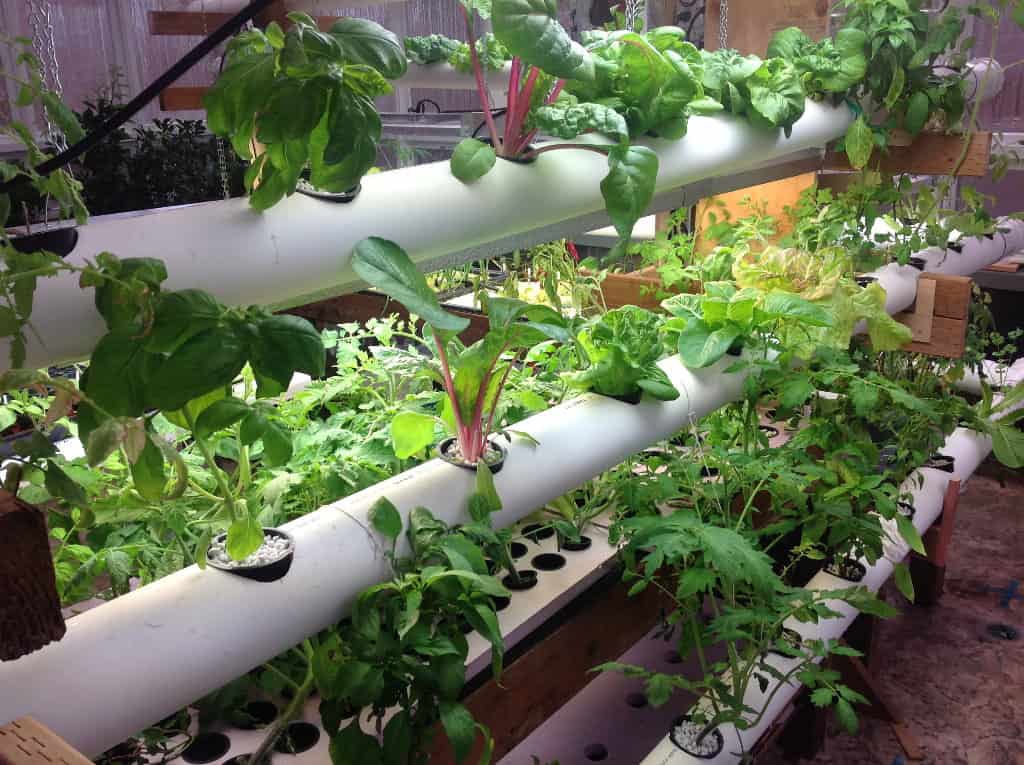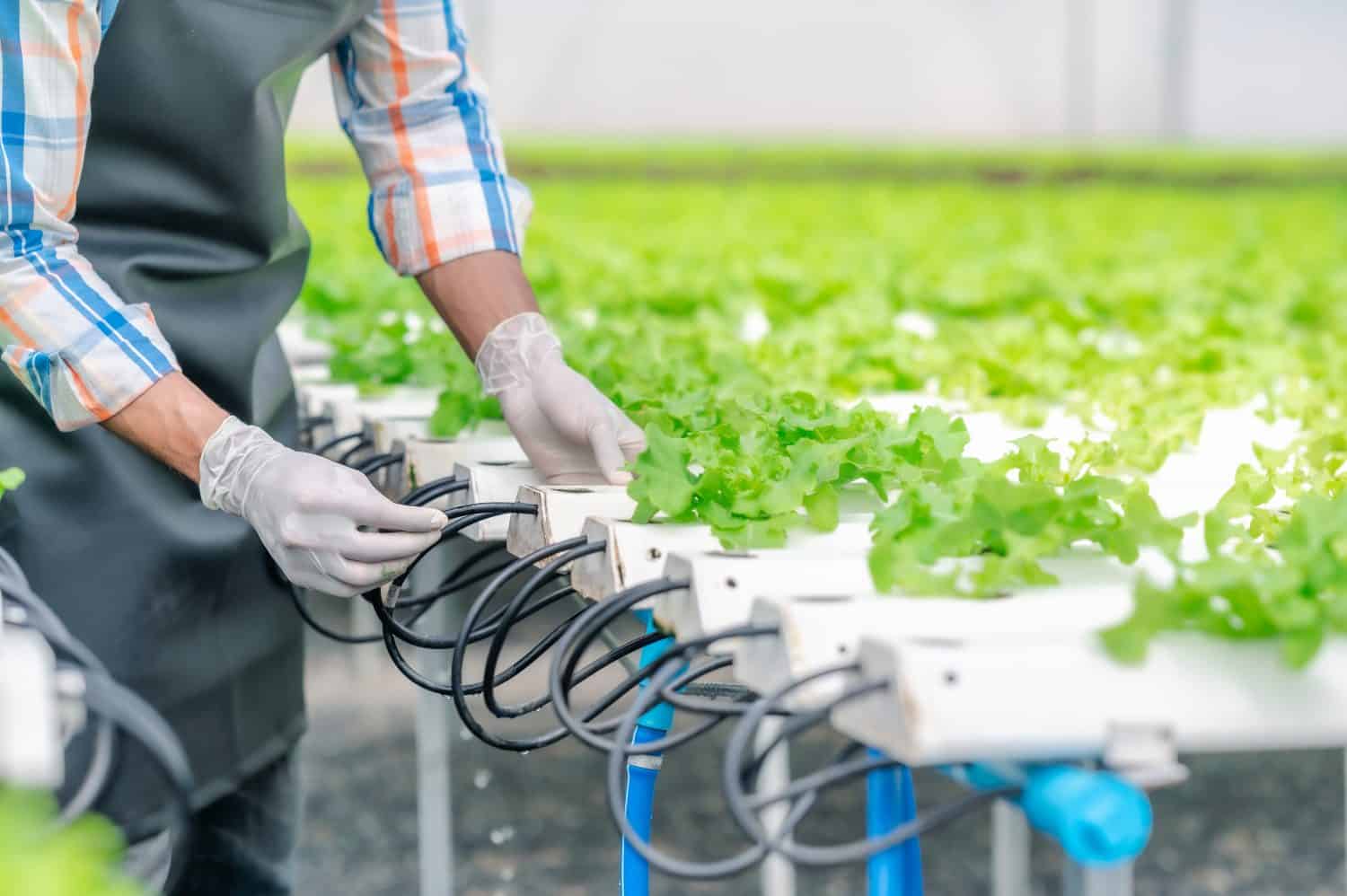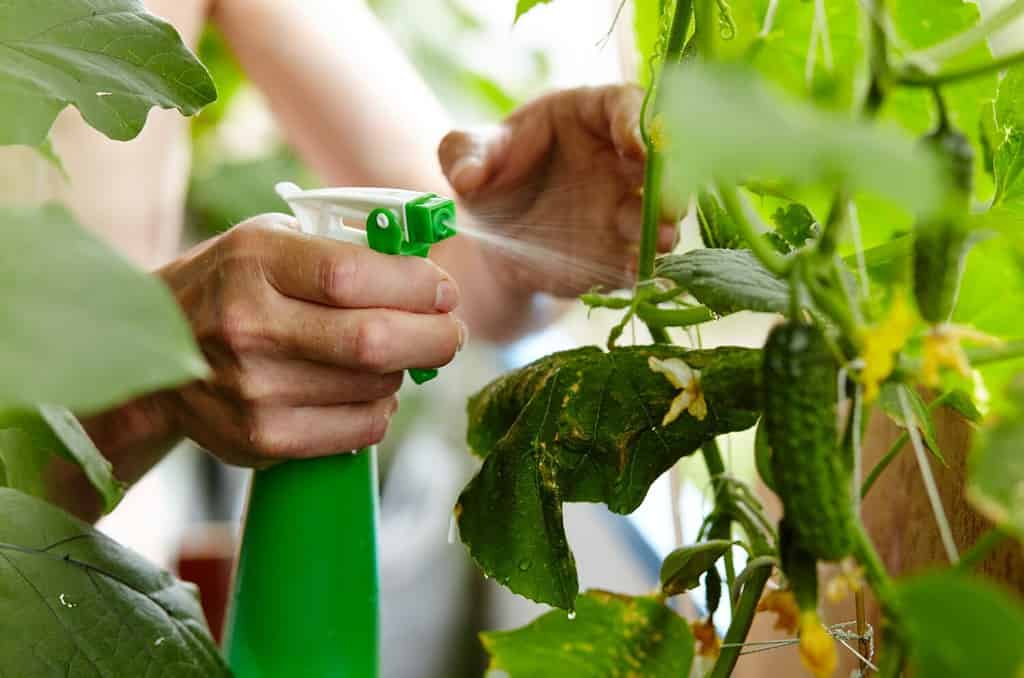Cucumbers are a refreshing summer treat, and where the proper growing zones exist, they can yield a prodigious number of fruits. What if you don’t live in the correct planting zone or want to enjoy your cucumbers year-round? A hydroponic growing system might be just the thing for you. This article will discuss how to grow cucumbers in a simple hydroponic system.
About the Cucumber

Growing hydroponic cucumbers can be a rewarding experience.
©eurobanks/Shutterstock.com
Cucumbers (Cucumis sativus) love sunlight, warm temperatures, and water. Plant types for cucumbers include vining or bush. Vining cucumbers can be supported on a trellis or other structure. Bush cucumbers are ideal for smaller gardens or container planting. Culinary distinctions include pickling cucumbers and slicing cucumbers. Pickling cucumbers are shorter and stubbier, while the slicing varieties are longer and have a more delicate skin.
What Is Hydroponics?
Hydroponics is a method of growing plants in a nutrient-enriched water solution rather than soil. There can also be an additional artificial medium, such as the mineral compound vermiculite, coconut fiber (coir), clay pebbles, or a kind of volcanic glass called perlite.
What Are the Pros and Cons of Growing Cucumbers This Way?
| Pros | Cons |
|---|---|
| It requires no soil. | Power failures can cut off light and power. |
| It saves water because it is recirculated and reused, and it’s not lost to soil or runoff. | Systems can be expensive to set up. |
| Hydroponic crops can have a high yield. | Hydroponics require more care and maintenance. |
| Crops grow quickly. | Some waterborne diseases may spread more quickly in this environment. |
| It is susceptible to fewer diseases. | |
| Fewer pests are in its growing environment. | |
| Crops can grow in arid or cold climates. | |
| There is no weeding or cultivation. | |
| Hydroponic plants are less likely to suffer transplant shock. | |
| Some crops, like lettuce, can be grown at waist height, making them easier to harvest for a better work environment. |
Different Hydroponic Approaches

Many methods for growing hydroponic cucumbers are suitable for home growers or large agricultural enterprises.
©Oregon State University / CC BY-SA 2.0 – License
The Three Components
There are three components to a hydroponic system. The first is whether a system is active or passive. A dynamic system will pump the nutrient solution through the plant roots. A passive system relies on the capillary action of a wick or growing medium to draw the nutrients from a reservoir.
The second component of a hydroponic system is whether the system is open or closed. An open system directs the nutrient solution into the growing medium, and the solution is not reused. A closed system will recirculate or reuse the nutrient solution.
The final component of a hydroponic system is whether the system sits in a liquid or an aggregate. A liquid hydroponic system will suspend the roots in the solution with no growing medium. An aggregate system will rely on a medium to support the roots.
Popular Systems
Ebb and Flow
The ebb and flow system is a liquid active recovery system. It has a reservoir with a submersible pump. The plants are kept in a tray above it. The nutrient solution is pumped up around the roots in the tray, which will flood for about 20 to 30 minutes and then drain back into the reservoir.
Nutrient Film Technique (NFT)
The nutrient film technique (NFT) is a liquid active recovery hydroponic system. The NFT uses grow tubes and a reservoir with a submersible pump. The grow tube is angled downwards, allowing the nutrients to flow through the roots and back into the reservoir. These nutrients flow through the roots 24 hours a day.
Wick System
The wick system is an aggregate passive non-recovery hydroponic system. It has no pump and no moving parts. The plants are in a growing medium, often like sand or a perlite/vermiculite mix. Nutrients move from a reservoir up into the roots of the plants by the capillary action of a cotton fiber or lantern wick.
Floating Raft System
With the floating raft system, another passive system, the seedlings begin in a growing medium. They are then transplanted onto a raft, which floats on the nutrient solution, which the roots dangle in.
Hydroponic Drip System
Hydroponic drip systems are probably the most widely used ones in the world. A timer controls a submersible pump in the nutrient reservoir. When the timer switches on, the nutrient solution is applied to the base of each plant (seated in a medium) using a small drip line.
Aeroponic System
An Aeroponic System allows the roots to be suspended in the air, gaining greater access to oxygen and nutrients and improving the yield. In an aeroponic system, the roots are misted frequently—sometimes as often as every few minutes.
Deep Water Culture (DWC)
Deep Water Culture (DWC) uses a deep reservoir. Most of the plant’s root system is also submerged all of the time. The system is very stable and requires less oversight. It’s also straightforward to assemble. An air stone or an air diffuser can provide the oxygen.
Choose the Best System for Your Cucumbers
Many of the systems above work better for large-scale operations. Two options work better for beginning small-scale systems. One option is an ebb-and-flow system using coconut coir or perlite as a medium. However, DWC is even simpler and provides an excellent introduction to hydroponics for beginners.
Setting Up Your Hydroponic System

Some hydroponic systems can be costly and complicated, while others can be done in a small space with relatively few materials.
©interstid/Shutterstock.com
Choose a Location
Choose a location that gets plenty of light and has protection from the wind. Also, ensure you have plenty of vertical space—cucumber plants need a lot. A greenhouse is a great location or under the overhang of a house or garden. Cucumbers can stand a lot of rain, but ensure the container is closed to prevent excess rainwater from getting into the reservoir.
Build Your System
Fill a 5-gallon bucket with water and add the nutrients. Create holes in the lid to accept net pots (cup-like containers with holes allowing root growth). Drill a hole near the top to accept an air hose. Attach the airline to an air pump. Attach the line to an air stone, and then place the air stone inside the bucket in the reservoir.

Cucumbers grown in a hydroponic environment can sprout rapidly.
©Xanya69/Shutterstock.com
Prepare the Nutrient Solution
Any water source can be used, whether tap, distilled, well, or water purified through reverse osmosis. Whatever source you use, you need to eliminate non-beneficial chemicals or minerals. With tap water, this means removing chlorine or chloramine. Expose tap water to sunlight for 24 hours or boil it to eliminate chlorine. Use carbon filtration to remove chloramine. You also need to adjust the pH and ppm. Check the pH levels with a meter and adjust them with a pH kit. Make sure the pH levels are between 5.5 and 6.5. ppm levels should be within the 200 to 300 range. Use carbon filters to lower ppm, and add nutrients to raise it.
Start Your Seeds
Decide on some cucumber seeds. European seeds are a good choice because the plants are self-pollinating. Avoid field cucumber seeds. They do not work well for hydroponics.
When choosing a medium, select one that works well with your system. Starter plugs are a good choice for DWC. Place these in your seeding tray, soak them with water, and drain the excess—plant one seed in each plug, about a quarter of an inch deep. Cover the tray with a lid and place it in a cool area under a grow lamp or in diffused sunlight, as in a greenhouse.
At the germination phase, the seeds have everything they need to grow, and you don’t need to add fertilizer to get them to germinate. When placing the seeds in the medium, ensure you put them so the roots will grow down. Position the seeds so that the part of the seed that was initially attached to the plant faces down. This ensures that the roots have a direct path to the nutrient solution.
Transfer Seedlings to Your Grow Tray Above the Reservoir
Once the seeds have sprouted (about 3-10 days), place the plants with visible roots growing from the starter plugs into net pots. Surround them with a growing medium like clay nodules, and then set them in the bucket’s lid so the roots reach the solution.
Care For Your Cucumbers

Hydroponic cucumbers can require a lot of care and attention.
©Andrii Salomatin/Shutterstock.com
Temperature
Keep the temperature of the water between 65 and 80° Fahrenheit. The roots will be susceptible to disease if the water is too warm. If it’s too low, the plants will act as if the growing season is over, going into winter mode.
Lighting
The plants should receive 12 to 14 hours of light a day. If you are growing indoors or the season doesn’t allow for that much sunlight, grow lights are a good substitute.
Maintain Water and Nutrient Levels
You don’t want the solution to evaporate away from the roots, so add water and nutrients to maintain a proper level below the plant body. As the roots grow, let the water drop a little. The oxygen between the plant base and the nutrient solution is good for the plants, and the roots will grow toward the nutrient and water solution.
Providing a Support System
The increased yield and growth rate of hydroponic cucumbers means that these viney plants will require some support. A suspended twine or a trellis system will help control growth within a vertical space.
Replace the Solution and Clean the Container
Approximately every three weeks, replace the nutrient solution and clean the container. This is to prevent an excess of nutrient buildup and root burn. It will also keep diseases from taking root in the system. Have an extra bucket handy to support the growth tray and protect the roots while the reservoir is cleaned. After cleaning, rinse the reservoir thoroughly to remove any remaining cleaning solution.
Pests and Disease Prevention
Cucumbers grown indoors are less susceptible to pests, though spider mites and aphids can still be problematic. Monitor your plants and kill these pests by hand when you see them. Avoid fungal diseases and mildew by limiting humidity in the growing environment and providing plenty of ventilation.
Harvesting Your Cucumbers—When and How?

However they’re grown, cucumbers make a tasty treat!
©Sunvic/Shutterstock.com
Germination happens within 3-10 days, and the plant will begin to yield fruit within four to six weeks. As the young plant develops, remove flowers up to about the tenth leaf. This will encourage the plant to grow strong before being burdened with more cucumbers than it can bear. Young cucumbers have ribs along their length. Pick the cucumbers before they fill out so much that the ribs disappear. Use pruning shears to clip the vine above the cucumber or lift the flower’s end straight up until it separates from the vine.
Storing Your Cucumbers
After picking, do not refrigerate your cucumbers. Store them at a temperature of between 50 and 65 degrees Fahrenheit. Thin-skinned European cucumbers should be wrapped in plastic food wrap to retain their moisture.
The photo featured at the top of this post is © PixaHub/Shutterstock.com
Thank you for reading! Have some feedback for us? Contact the AZ Animals editorial team.






